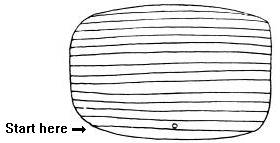The Rongorongo of Easter Island
Item C: The Mamari Tablet
Numerical transliteration
Barthel's tracings:
| Lines | 1-2 | 3-4 | 5-6 | 7-8 | 9-10 | 11-12 | 13-14 |
| Side a | Ca1-2 | Ca3-4 | Ca5-6 | Ca7-8 | Ca9-10 | Ca11-12 | Ca13-14 |
| Side b | Cb1-2 | Cb3-4 | Cb5-6 | Cb7-8 | Cb9-10 | Cb11-12 | Cb13-14 |
General Aspect
 |
|
| Side a |
|
 |
|
| Side b | |
| The Mamari Tablet is the only rongorongo text the meaning of part of which is known: a lunar calendar identified as such by Thomas Barthel in 1958, extending from line 6 to line 8 of side a (Ca6:235-Ca8:175). Jacques Guy (1991) has argued that, rather than a lunar calendar proper, those signs constitute in fact an astronomical canon for predicting in advance when intercalary nights should be inserted in the calendar to keep with the moon phases. |
Photographs


Click on images above for larger pictures
Home Corpus Lunar calendar
Go to item: A | B | C | D | E | F | G | H | I | J | K | L | M | N | O | P | Q | R | S | T | U | V | W | X | Y | Z